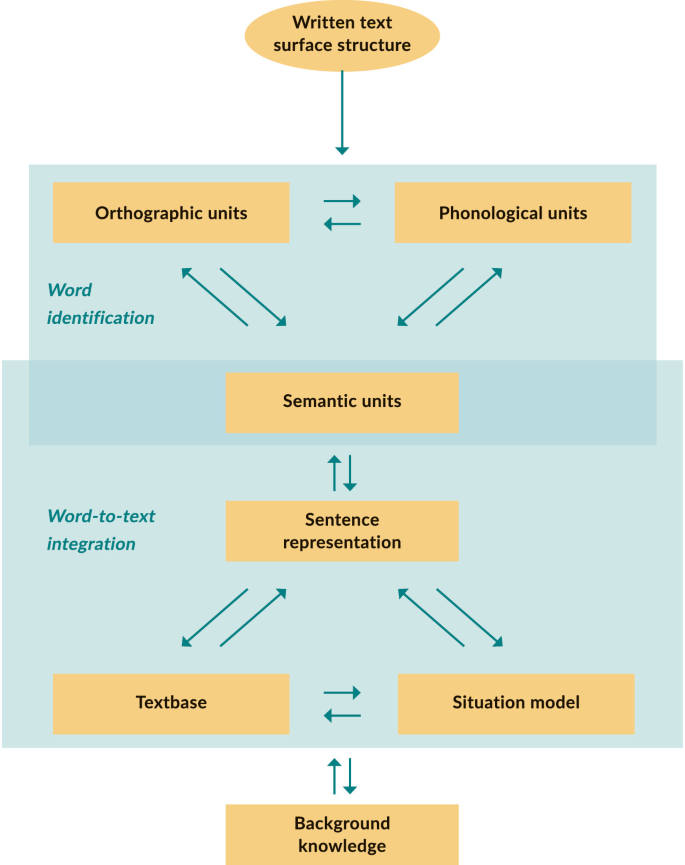Abstract
This chapter aims to provide teachers with a brief overview of the current state of affairs in reading comprehension research, serving as a frame of reference and support for the rest of the book. Comprehending a written text requires the reader to identify the words used in the text, combine single word meanings into propositions, and subsequently create a coherent and adequate model of the text. Together with relevant background knowledge, a shallow textbase can be enhanced into a more in-depth situation model which depicts the situation described in the text. There are a number of factors that have proven to have an impact on how well a reader understands a text, such as word identification abilities, language comprehension abilities, the use of reading comprehension strategies, and reading motivation. Also in this chapter, the various purposes of reading and processes for comprehension as described in the PIRLS assessment framework are explained.
You have full access to this open access chapter, Download chapter PDF
Keywords
- Reading comprehension
- Text model
- Reading factors
- Reading purposes
- Comprehension processes
- Progress in International Reading Literacy Study (PIRLS)
1 Introduction
Reading comprehension is a crucial skill in modern-day society. Readers lacking comprehension skills face challenges in everyday life, from understanding a medicine’s package insert to dealing with online information, and acquiring new knowledge. But what does it mean to comprehend a text? What does it take for the reader to arrive at comprehension? This chapter aims to provide teachers with a brief overview of the current state of affairs in reading comprehension research, serving as a frame of reference and support for the rest of this book. At the end of this chapter, reading tips are provided for those who are interested in learning more about theories of reading comprehension and reading comprehension research.
In accordance with recent comprehension models and the Progress in International Reading Literacy Study (PIRLS) framework, reading literacy can be defined as:
the ability to use and understand those written language formats required by society and/or valued by the individual. Readers can construct meaning from written texts in a variety of forms. They read to learn, to participate in communities of readers in school and everyday life, and for enjoyment (Mullis & Martin, 2019, p. 6).
This definition of reading comprehension reflects various theories in which reading comprehension is seen as a constructive and interactive process. It is the product of the interaction between factors at both the level of the reader and the text (Kintsch, 1998; Perfetti & Stafura, 2014; Van den Broek et al., 1999). Reading comprehension, therefore, requires a broad set of skills and a certain level of prior knowledge on the part of the reader. In addition, the present definition also reflects three overarching purposes for reading, namely, reading for pleasure and personal interest, learning, and participation in society. Young readers’ reading is mainly centered around the first two reading purposes. Therefore, the PIRLS assessment framework is focused around these two, using narrative texts to assess literary experience (pleasure and personal interest) and informative texts to assess the acquisition and use of information (learning).
Regardless of the purpose of reading, comprehension ideally results in an adequate and representative model of the text. According to the construction-integration model of reading comprehension, texts are represented at three levels: the surface structure, the textbase, and the situation model (Kintsch, 1998). The surface structure consists of the words in the text and the ideas that these words represent. The ideas are referred to as propositions and reflect what is explicitly stated in the text (i.e., facts, events, feelings, etc.). The textbase is created by connecting the single propositions and “represents the meaning of the text, as it is actually expressed by the text” (Kintsch & Rawson, 2005, p. 211). Although the textbase provides the reader with information stated in the text, comprehension will be shallow since the reader understands only what is explicitly stated in the text. For a deeper understanding, the reader has to create a model of the situation. Creating such a situation model requires the integration of both information explicitly stated in the text (i.e., the textbase) and relevant prior/background knowledge.
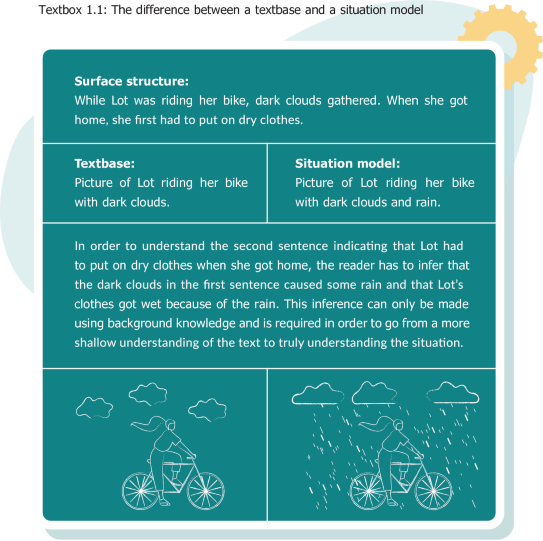
2 What Does it Take to Comprehend a Text?
Understanding a written text is a complex process and in order to recognize what it takes to comprehend a text, it is important to know how readers construct meaning from a text. According to the Simple View of Reading (SVR) model (Gough & Tunmer, 1986), reading comprehension involves two main skills: being able to identify the words in a text by converting letters into sounds and combining these into words (i.e., decoding) and the ability to comprehend orally presented information (i.e., language comprehension). The SVR model states that comprehension is not merely the sum of both decoding and language comprehension skills, but that it can be seen as the product of it: reading comprehension = decoding x language comprehension, with scores for decoding and language comprehension ranging between 0 and 1. This formula indicates that to become a reader with strong comprehension, both skills need to be developed; when one falls behind, the other skill can compensate a little, but the reader will never become a strong reader with strong comprehension (0.1 × 1 = 0.1 and 1 × 0.1 = 0.1). So, in order to become a good reader, both skills need to be addressed in school. However, as both skills can be divided again into many subskills (Scarborough, 2001), this is not an easy task.
Although numerous studies support the SVR model, it has been suggested that it is limited in the role it awards to language-specific factors, such as word knowledge (i.e., vocabulary), and that it does not do justice to the complexity of the reading comprehension process. To understand the complex process, a more general framework highlighting various factors is necessary. The Reading Systems Framework (RSF) (Perfetti & Stafura, 2014), is such a framework. According to the RSF, comprehension requires two main subprocesses: word identification and word-to-text integration. Word identification refers to the process of converting letters into sounds, combining these sounds into words, and assigning meaning to the words being read. Activated word meanings, which are stored in the mental lexicon (see Textbox 1.2), are not only seen as the output for word identification, they also function as the input for word-to-text integration. Words that are just activated have to be integrated in order to form a representation of the text. This is referred to as word-to-text integration. In other words, from single words, readers create sentences by integrating single word meanings, which in turn can be combined into a text model (i.e., textbase) and finally a situation model can be constructed. Finally, the RSF places a great deal of importance on incorporating relevant background knowledge to go from a more shallow textbase or text model to a more in-depth situation model. Here, background knowledge does not only refer to knowledge about the subject of the text, but also to knowledge about text structures, text genres, purposes for reading, and the use of reading comprehension strategies. One important aspect that is not covered in the RSF is motivation. It has been suggested that motivation plays a crucial role in becoming a good comprehender (Toste et al., 2020).
In the remainder of this chapter, the role of word identification, word-to- text integration, use of comprehension strategies, and motivation in supporting comprehension of written texts will be discussed in more detail. We have listed a few reading tips at the end of this chapter for teachers who are interested in reading more on the role of these four factors or who want to learn more about the impact of other factors on reading comprehension.
2.1 Word Identification
In order to become successful in comprehension, the reader has to develop fluent word identification skills. This is necessary, as all cognitive processes needed to comprehend a written text require part of the reader’s limited cognitive resources. To ensure that enough cognitive resources remain available for the comprehension processes, it is important that word identification becomes automatic and does not require too much effort from the reader. Word identification, as the term suggests, is the ability to identify words and consists of two steps: decoding and retrieving semantic information from long-term memory. Word identification starts with decoding, the process of converting strings of letters (orthographic units, known as grapheme) into their corresponding sounds (phonological units, known as phoneme). Becoming a fluent decoder generally is a matter of “practice makes perfect.” When children are still learning to crack the code, decoding is a slow and effortful process. Each grapheme has to be consciously converted into its corresponding phoneme, and these phonemes need to be combined into single words. However, the more children practice, the more automatic these actions become. During the primary school years, children rapidly become faster readers (Verhoeven et al., 2011), a process that continues well into adolescence. For most readers, decoding becomes a fast and effortless process, as relating sounds to letters takes less effort as more and more words are (partly) recognized on sight. The ease with which decoding becomes a fast and effortless process partly depends on the language in which students learn to read, and specifically on the transparency of the language (Patel et al., 2004). Transparency of a language has to do with the consistency with which letters correspond to sounds. A language is said to be transparent when consistency between written letters and sounds is high and single letters generally correspond to a single sound, making it easy to convert a string of letters into a word. Examples of transparent languages are Italian, Spanish, and Indonesian. A language is said to be opaque when consistency between written letters and sounds is low and single letters can correspond to more than one sound. An example of a very opaque language is English. Languages such as French, Persian, and Dutch are in the middle. Research has shown that it is easier to learn how to decode words in transparent languages compared to more opaque languages (Patel et al., 2004).
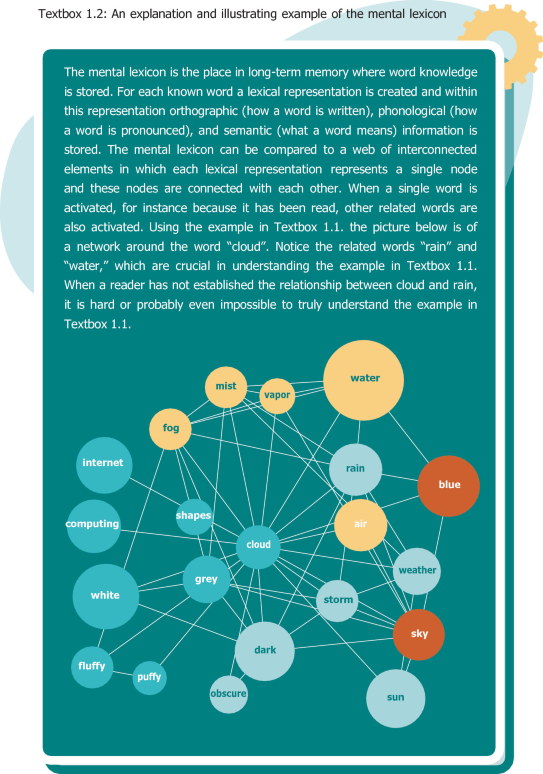
As noted before, word identification is more than being able to decode words; it also includes retrieving semantic information from long-term memory. In other words, after a word has been decoded, information about the meaning of that word becomes activated and the reader can use it to create an understanding of the text. The difference between word identification and its subprocess of decoding can best be illustrated by the following example. An experienced reader is able to easily decode the pseudoword (i.e., nonword) “stremkra.” They can convert the orthographic representation (i.e., the written form) into a phonological one (i.e., how it is pronounced). However, while decoding it, no semantic information can be retrieved, since it is not a real word. So, although decoding is possible, identification is not. For the word “rabbit” the situation is different. For most readers, it is easy to identify. Not only do they know how to read the word rabbit, they are also able to retrieve its meaning. In other words, most readers know how to decode it and know what a rabbit looks like, where they live, what colors they can have, that they are usually fluffy, etc.
Word identification is influenced by how well a reader knows a word. For each known word, a lexical representation is stored in the readers’ mental lexicon containing information about its written form (orthography), pronunciation (phonology), and meaning (semantics). The quality of these representations depends on how well you know the written form of a word, know how to pronounce it, and know what it means. Researchers refer to this as lexical quality (Perfetti, 2007). Lexical quality varies largely between children: some children know more words and know more about these words than others. Lexical quality also varies within children: some words are easier to spell, pronounce, and understand (i.e., table) as compared to others (i.e., bureaucracy). Low lexical quality is a main cause of poor comprehension. Not only is decoding easier when the reader has access to well-specified lexical representations in terms of how words are written, how they are pronounced, and what they mean (Dyson et al., 2017), but research has also shown that in order to understand a text, the reader has to know the meaning of at least 90–95% of the words in a text (Nagy & Scott, 2000).
2.2 Word-to-Text Integration
To comprehend a text, in addition to the ability to read it, the reader has to integrate the individual word meanings into a sentence representation and combine all sentences into a mental model of the text. In other words, in addition to word identification, the comprehension process entails integrating single word meanings into propositions which in turn can be used in order to create the textbase and situation models. This is referred to as word-to-text integration. Combining single words into accurate propositions is crucial in understanding the text: the man chases the dog is different from the dog chases the man. Although the same five words are used, the meaning of the sentence and, therefore, the meaning of the textbase is completely different. The development of language comprehension skills and integration skills more specifically, starts early on, long before children start to learn to read and identify words. As early as preschool and kindergarten, children develop language skills, such as the ability to generate and memorize sentences and use their vocabulary knowledge, factors that both predict initial reading comprehension ability and its growth (Hjetland et al., 2019).
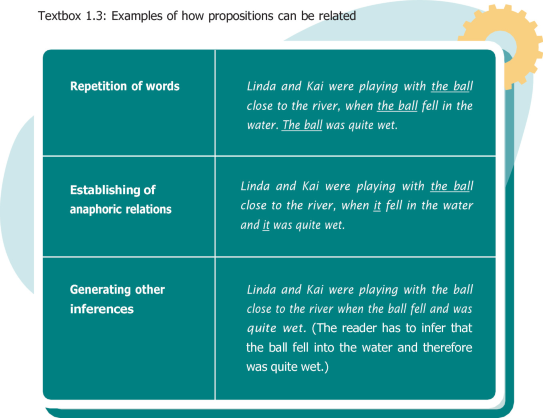
In comprehending a text, it is not only important to create and understand propositions, but the different propositions also have to be brought together. Just as with creating propositions, combining propositions is a delicate process in which the reader needs to understand the interrelations between two or more pieces of information. There are various ways in which propositions can be related, for example, by the repetition of words, through establishing anaphoric relations, and by generating other types of inferences (see Textbox 1.3).
As indicated above, together these propositions form the textbase. With inclusion of the reader’s own relevant prior knowledge but also by using knowledge on text structures, text genres, and the use of comprehension strategies (see Sect. 1.2.3), the reader is able to generate a model of the situation described in the text: the situation model. Relevant background knowledge is thus a crucial part of reading comprehension.
The complete process of creating propositions and combining them into an adequate model of the text can be referred to as word-to-text integration, and readers vary in how these integration skills are developed. One major impacting factor is lexical quality (Perfetti, 2007). Just as with word identification, the amount and quality of word knowledge (written form, pronunciation, and meaning) stored in the mental lexicon has an impact on the ease with which a reader can create a model of the text and the quality of the model. During the integration process, information about the meaning of the word from the semantic constituent is used to connect a word or sentence to the text model created up to that point. Readers with many high-quality lexical representations are able to activate more semantic knowledge, assigning the correct meaning given the context in which the word is used, making it easier to create propositions and combine these into a model of the text. Semantic information, in particular, can aid this integration process. The more semantic information available, the easier it is to create accurate propositions and integrate these propositions into the model of the text.
In addition to individual variations in word-to-text integration abilities, due to differences in lexical quality, variations in texts may have an impact on how easy it is to create a model of the text. Cohesion and genre are two relevant textual factors (McNamara et al., 2011). Text cohesion refers to the degree in which a text provides explicit cues to help the reader relate information from the text. Texts with low cohesion require a lot of inferences from the reader, while highly cohesive texts do not. The latter are thus easier to comprehend. Similarly, readers find it easier to make inferences in narrative texts, as they describe topics that the reader has prior knowledge of (e.g., friendship). Results from a recent meta- analysis confirm that readers generate more inferences during narrative reading as compared to reading expository texts (Clinton et al., 2020). When it is easier to generate inferences, it is easier to create a textbase and situation model and consequently demonstrate understanding of the text.
2.3 Comprehension Strategies
A reading strategy can be seen as a “mental tool” that readers can use to support, monitor, and restore their understanding of the text (Afflerbach & Cho, 2009). Readers with strong comprehension skills can be characterized as strategic readers, who both consciously and unconsciously use specific strategies to solve comprehension difficulties and regulate their own reading behavior. Strategies can be divided into cognitive comprehension strategies and metacognitive comprehension strategies.
Cognitive comprehension strategies help the reader to create a coherent and adequate situation model of the text and therefore directly enhance comprehension. These mental tools aid the reader in understanding what they have read by either performing activities before, during, or after reading. Examples of effective cognitive comprehension strategies are: making predictions (before reading), asking questions (during reading), and visualizing the content of the text (after reading). Metacognitive comprehension strategies are used to monitor and evaluate whether the constructed mental model (the situation model) is accurate and fits the reading purpose. Examples of effective metacognitive comprehension strategies are: setting reading goals (before reading), monitoring of understanding (during reading), and clarifying of uncertainties (after reading).
Both types of strategies, cognitive and metacognitive, work in conjunction with each other. When a reader, for instance, signals that they do not understand what has just been read (metacognitive comprehension), the reader can ask themselves questions concerning the text (cognitive comprehension) in order to enhance comprehension of that part of the text. Successful readers are able to regulate their use of cognitive and metacognitive reading strategies (Andreassen et al., 2017). The most effective comprehension strategies are further discussed in Sect. 2.2.3.
So far, it has been shown that according to a more interactive model of reading comprehension, RSF, two main subprocesses are in play: (1) word identification where orthographic, phonological, and semantic knowledge is important and activated word meanings are the outcome, and (2) word-to-text integration where these activated word meanings are integrated into sentences, a textbase, and, together with relevant background knowledge, a situation model. A schematic representation of the RSF is presented in Fig. 1.1.
A schematic overview of the comprehension process described in the Reading Systems Framework (RSF), with word identification and word-to-text integration as the two main subprocesses acting in parallel (Note This figure is an adapted version of the figure presented in Perfetti & Stafura[, 2014])
2.4 Motivation
Grade 4 has been associated with a so-called “fourth-grade slump” (Chall & Jacobs, 2003). Around this grade, children gradually progress from learning to read to reading to learn and this is one of the reasons why it is so interesting and important to examine children’s reading comprehension skills in grade 4 as is the case with PIRLS. The slump itself refers to the stagnation in growth in reading comprehension starting in fourth grade as children transition from “learning to read” to “reading to learn”, and is especially prominent in children with a lower social-economic background (Chall & Jacobs, 2003). Less extensive vocabulary seems to partially cause these problems. Additionally, children with poorer comprehension also tend to lose their motivation to read, thus entering a negative, downward spiral in reading comprehension. An upward spiral of causality has also been documented: more proficient readers are more motivated to read, read more, and further improve their skills (Mol & Bus, 2011).
A meta-study has shown that the nature of the relation between reading skills and motivation is indeed bidirectional (Toste et al., 2020), indicating that not only does motivation have an impact on the ability to comprehend a written text, but that comprehension skills also have an impact on motivation to read. In other words, well-developed comprehension skills boost children’s motivation to read and children with more motivation read more frequently, with more pleasure, and develop better reading comprehension skills. The opposite is also true; children with comprehension difficulties are often less motivated to read and therefore read less and have fewer opportunities to develop their comprehension skills, resulting in less-developed skills. However, overall, the conclusion is that success is more important for motivation than motivation is for success.
3 Four Main Processes for Comprehension
In the previous section, it has been shown that, at the surface level, readers use the text to create propositions and combine these propositions into a textbase. The textbase functions as a model of the information stated in the text. By incorporating relevant background knowledge, readers transform the textbase into a situation model. This model is a representation of the situation described in the text. Both well-developed word identification and word-to-text integration skills are crucial. To gain more insight into how readers understand a written text, four processes can be distinguished (as described in the PIRLS assessment framework):
(1) focusing on and retrieving information explicitly stated in the text, (2) making straightforward inferences, (3) interpreting and integrating ideas and information, and (4) evaluating and critiquing content and textual elements.
Although text features such as length, abstractness of ideas, and text structure impact the ease with which the four processes can be carried out, retrieving information and making straightforward inferences generally are less difficult as compared to interpreting and integrating ideas, and evaluating and critiquing context and textual elements. However, text features can have an impact. Generating inferences, for example, in a relatively long text with a less transparent (coherent) structure can be harder than interpreting information in a relatively short text with a clear structure. In addition, reading goals can determine which processes are required in order to reach them. For example, the search for the opening hours of your local library requires you to focus on and retrieve information explicitly stated in a brochure about the library, but it probably needs less evaluating and critiquing of the content. Textbox 1.4 gives a brief overview of what these four processes entail.
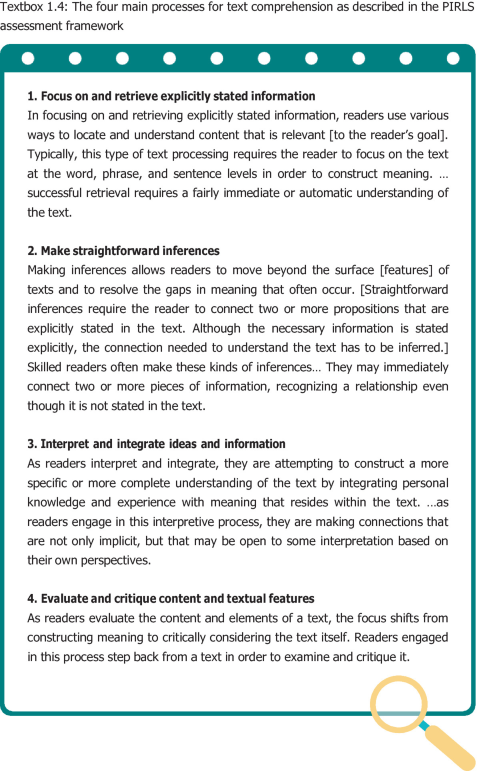

In addition to the two purposes of reading described briefly in Sect. 1.1 (reading for literary experience and reading to acquire and use information), these four comprehension processes are also distinguished within the PIRLS assessment framework. PIRLS results therefore provide teachers and policymakers with information on how well students are able to carry out these four processes in order to understand texts written to entertain readers (literary experience) or to teach them new information (acquire and use information). In Chapter 3, two PIRLS passages (one narrative for literary experience and one expository for acquiring and using information) will be addressed, providing examples of these four processes. Additionally, information will be shared on which skills children need to develop to successfully complete these processes and also offer didactic (see Textbox 1.5) suggestions, in order to help them develop better comprehension skills. In the next chapter, insights on evidence-based didactic principles are presented.
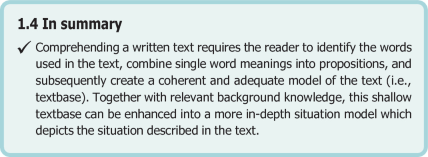


Reading Tips
-
Title: Understanding and teaching reading comprehension: A Handbook. Authors and year: Jane Oakhill, Kate Cain, & Carsten Elbro (2015). Publisher: Routledge.
-
Title: Ending the reading wars: Reading acquisition from novice to expert. Authors and year: Anne Castles, Kathleen Rastle, & Kate Nation (2018). Publisher: Article in: Psychological Science in the Public Interest (Vol 19, Issue 1, pages 5–51)
-
Title: Reading development and difficulties. Authors and year: Kate Cain (2010). Publisher: John Wiley And Sons Ltd.
-
Title: Bringing words to life. Robust vocabulary instruction. Authors and year: Isabel Beck, Margaret McKeown, & Linda Kucan (2013). Publisher: Guilford Publications.
-
Title: Developing reading comprehension. Authors and year: Paula Clarke, Emma Truelove, Charles Hulme, & Margaret Snowling (2014). Publisher: John Wiley & Sons, Ltd.
-
Title: What is disciplinary literacy and why does it matter? Authors and year: Timothy Shanahan & Cynthia Shanahan (2012). Publisher: Article in: Topics in language disorders (Vol 32, Issue 1, pages 7‒18)
-
Title: Approaching difficulties in literacy development. Authors and year: Felicity Fletcher-Campbell, Janet Soler & Gavin Reid (Eds.) (2009). Publisher: The Open University
References
Afflerbach, P., & Cho, B. (2009). Identifying and describing constructively responsive comprehension strategies in new and traditional forms of reading. In S. E. Israel & G. G. Duffy (Eds.), Handbook of research on reading comprehension (pp. 69–91). Routledge.
Andreassen, R., Jensen, M. S., & Bråten, I. (2017). Investigating self-regulated study strategies among postsecondary students with and without dyslexia: A diary method study. Reading and Writing: An Interdisciplinary Journal, 30(9), 1891–1916.
Chall, J. S., & Jacobs, V. A. (2003). The classic study on poor children’s fourth-grade slump. American educator, 27(1), 14–15. https://www.aft.org/periodical/american-educator/spring-2003/classic-study-poor-childrens-fourth-grade-slump
Clinton, V., Taylor, T., Bajpayee, S., Davison, M. L., Carlson, S. E., & Seipel, B. (2020). Inferential comprehension differences between narrative and expository texts: A systematic review and meta-analysis. Reading and Writing, 33, 2223–2248.
Dyson, H., Best, W., Solity, J., & Hulme, C. (2017). Training mispronunciation correction and word meanings improves children’s ability to learn to read words. Scientific Studies of Reading, 21(5), 392–407.
Gough, P. B., & Tunmer, W. E. (1986). Decoding, reading, and reading disability. RASE: Remedial and Special Education, 7(1), 6–10. https://doi.org/10.1177/074193258600700104
Hjetland, H. N., Lervåg, A., Lyster, S. A. H., Hagtvet, B. E., Hulme, C., & Melby-Lervåg, M. (2019). Pathways to reading comprehension: A longitudinal study from 4 to 9 years of age. Journal of Educational Psychology, 111(5), 751.
Kintsch, W. (1998). Comprehension: A paradigm for cognition. Cambridge University Press.
Kintsch, W., & Rawson, K. A. (2005). Comprehension. In M. J. Snowling & C. Hulme (Eds.), The science of reading: A handbook (pp. 211–226). Blackwell Pub.
McNamara, D. S., Ozuru, Y., & Floyd, R. G. (2011). Comprehension challenges in the fourth grade: The roles of text cohesion, text genre, and readers’ prior knowledge. International Electronic Journal of Elementary Education, 4(1), 229–257.
Mol, S. E., & Bus, A. G. (2011). To read or not to read: A meta-analysis of print exposure from infancy to early adulthood. Psychological Bulletin, 137(2), 267.
Mullis, I. V., & Martin, M. O. (Eds.). (2019). PIRLS 2021 assessment frameworks. Boston College, TIMSS & PIRLS International Study Center. https://timssandpirls.bc.edu/pirls2021/frameworks/
Nagy, W. E., & Scott, J. A. (2000). Vocabulary processes. In M. L. Kamil, P. B. Mosenthal, P. D. Pearson, & R. Barr (Eds.), Handbook of reading research (Vol. 3, pp. 269–284). Lawrence Erlbaum Associates Publishers.
Patel, T. K., Snowling, M. J., & de Jong, P. F. (2004). A cross-linguistic comparison of children learning to read in English and Dutch. Journal of Educational Psychology, 96(4), 785–797.
Perfetti, C. (2007). Reading ability: Lexical quality to comprehension. Scientific Studies of Reading, 11(4), 357–383.
Perfetti, C., & Stafura, J. (2014). Word knowledge in a theory of reading comprehension. Scientific Studies of Reading, 18(1), 22–37.
Scarborough, H. S. (2001). Connecting early language and literacy to later reading (dis) abilities: Evidence, theory, and practice. In S. Neuman & D. Dickinson (Eds.), Handbook for research in early literacy (pp. 97–110). Guilford Press.
Toste, J. R., Didion, L., Peng, P., Filderman, M. J., & McClelland, A. M. (2020). A meta- analytic review of the relations between motivation and reading achievement for K–12 students. Review of Educational Research, 90(3), 420–456.
Van den Broek, P., Young, M., Tzeng, Y., & Linderholm, T. (1999). The landscape model of reading. In H. van Oostendorp & S. R. Goldman (Eds.), The construction of mental representations during reading (pp. 71–98). Erlbaum.
Verhoeven, L., van Leeuwe, J., & Vermeer, A. (2011). Vocabulary growth and reading development across the elementary school years. Scientific Studies of Reading, 15(1), 8–25.
Author information
Authors and Affiliations
Corresponding author
Rights and permissions
Open Access This chapter is licensed under the terms of the Creative Commons Attribution-NonCommercial 4.0 International License (http://creativecommons.org/licenses/by-nc/4.0/), which permits any noncommercial use, sharing, adaptation, distribution and reproduction in any medium or format, as long as you give appropriate credit to the original author(s) and the source, provide a link to the Creative Commons license and indicate if changes were made.
The images or other third party material in this chapter are included in the chapter's Creative Commons license, unless indicated otherwise in a credit line to the material. If material is not included in the chapter's Creative Commons license and your intended use is not permitted by statutory regulation or exceeds the permitted use, you will need to obtain permission directly from the copyright holder.
Copyright information
© 2022 The Author(s)
About this chapter
Cite this chapter
Bruggink, M., Swart, N., van der Lee, A., Segers, E. (2022). Theories of Reading Comprehension. In: Putting PIRLS to Use in Classrooms Across the Globe. IEA Research for Educators, vol 1. Springer, Cham. https://doi.org/10.1007/978-3-030-95266-2_1
Download citation
DOI: https://doi.org/10.1007/978-3-030-95266-2_1
Published:
Publisher Name: Springer, Cham
Print ISBN: 978-3-030-95265-5
Online ISBN: 978-3-030-95266-2
eBook Packages: EducationEducation (R0)


